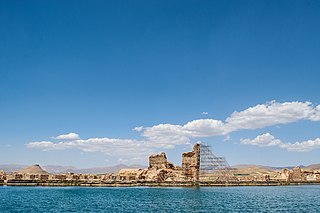 W
WAdur Gushnasp was the name of a Zoroastrian sacred fire of the highest grade, which served as one of the three most sacred fires of pre-Islamic Iran; the two others being the Adur Farnbag and Adur Burzen-mihr. Out of the three, Adur Gushnasp is the only fire whose temple structure has been discovered and "for which archaeological, sigillographical, and textual evidence are all available."
 W
WAngra Mainyu is the Avestan-language name of Zoroastrianism's hypostasis of the "destructive/evil spirit" and the main adversary in Zoroastrianism either of the Spenta Mainyu, the "holy/creative spirits/mentality", or directly of Ahura Mazda, the highest deity of Zoroastrianism. The Middle Persian equivalent is Ahriman 𐭠𐭧𐭫𐭬𐭭𐭩.
Ahura is an Avestan language designation for a particular class of Zoroastrian divinities. The term is assumed to be linguistically related to the Asuras of Indian Vedic era.
 W
WAhurani is the Avestan language name of a Zoroastrian divinity associated with "the waters" (āpō). In scripture, the expression ahurani appears both in the singular and in the plural, and may - subject to context - either denote a specific divinity named Ahurani, or a class of divinities that are ahuranis.
Airyanem Vaejah is the homeland of the early Iranians and is mentioned in the Zoroastrian Avesta as one of Ahura Mazda's "sixteen perfect lands". Its actual location is believed to be Ariana
Ashavan is a Zoroastrian theological term. It literally means "possessing/mastering aša" and has been interpreted as "possessing/mastering truth" or "possessing/mastering righteousness", but has further implications:It is an epithet of Ahura Mazda. The term may then be applied to anything within the domain of Ahura Mazda and/or Aša, and excludes only that which is drəgvant "possessing lie". With respect to mortals and in an eschatological and sotereological context, ašavan is also a quality that can be acquired in life. Then, having acquired the qualities of an ašavan, one becomes an ašavan after death.. This sotereological meaning of ašavan is also evident in Xerxes' daiva inscription, an Old Persian text. This next-world meaning of ašavan is preserved in Middle Iranian languages as Pahlavi ahlav. Ašavan may be used to denote any follower of the "Good Religion." This is the most common use of ašavan, applicable to any who walk the "path of truth". In this context, Ašavan is frequently translated as "righteous person" or "blessed person." This general meaning of ašavan is preserved in Middle Iranian languages as Pahlavi ardav.
 W
WBagavan was an ancient locality in the central part of Armenia in the principality of Bagrevand. The site is located in the village of Taşteker to the west of modern Diyadin, Turkey. Situated on a tributary of the Euphrates at the foothills of Mount Npat, to the north of Lake Van, Bagavan held one of the major temples of pre-Christian Armenia. After the Christianization of Armenia, Bagavan became the site of a large church and monastery. Pillaged in 1877 by the Kurds, it was completely destroyed after 1915 during the Armenian genocide.
Criticism of Zoroastrianism has taken place over many centuries not only from the adherents of other religions but also among Zoroastrians themselves seeking to reform the faith.
The Cypress of Kashmar was sacred to followers of Zoroastrianism. According to the Iranian epic Shahnameh, the tree had grown from a branch Zoroaster had carried away from Paradise and which he planted in honor of King Vishtaspa's conversion to Zoroastrianism in Kashmar. On 10 December 861 AD, Abbasid Caliph al-Mutawakkil ordered the tree be felled and transported to his capital in Samarra where its wood would be used as beams for his new palace. But one day before the cypress trees arrived, the caliph was killed by Turkish slaves. The palace and its spiral minaret still stand today.
 W
WExegesis in Zoroastrianism is principally defined as the interpretation of Avesta, the Zoroastrian religious book. The Zend, an explanation of Avesta which is written in Pahlavi language and the other old texts related to Zoroastrian exegesis have no Avestan word. The religious legal textbooks like Vendidad, Neyrangistan, Hirbodistan, Hadokht Nask and Visperad are also interpretations of Avesta.
 W
WA fire temple, Agiary, Atashkadeh, Atashgah (آتشگاه) or Dar-e Mehr is the place of worship for the followers of Zoroastrianism, the ancient religion of Iran (Persia). In the Zoroastrian religion, fire, together with clean water, are agents of ritual purity. Clean, white "ash for the purification ceremonies [is] regarded as the basis of ritual life", which "are essentially the rites proper to the tending of a domestic fire, for the temple [fire] is that of the hearth fire raised to a new solemnity". For, one "who sacrifices unto fire with fuel in his hand ..., is given happiness".
 W
WGāh is a period of time which is dedicated to a Yazata in Zoroastrianism.
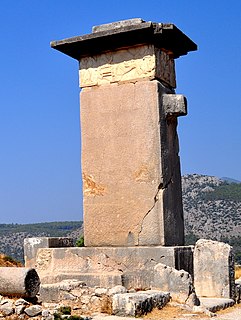 W
WThe Harpy Tomb is a marble chamber from a pillar tomb that stands in the abandoned city of Xanthos, capital of ancient Lycia, a region of southwestern Anatolia in what is now Turkey. Built in the Persian Achaemenid Empire, and dating to approximately 480–470 BC, the chamber topped a tall pillar and was decorated with marble panels carved in bas-relief. The tomb was built for an Iranian prince or governor of Xanthus, perhaps Kybernis.
The Irani are an ethno-religious community in the Indian subcontinent; they belong to the Zoroastrians who emigrated from Iran to British India in the 19th and 20th centuries. They are culturally, linguistically, ethnically and socially distinct from the Parsis, who – although also Zoroastrians – emigrated to the Indian subcontinent from Greater Iran many centuries before the Iranis did, starting with the Islamic Conquest of Persia by the Sunni Caliphate.
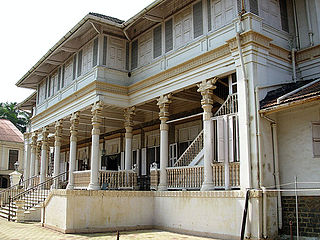 W
WThe Iranshah Atash Behram, also known as the Udwada Atash Behram is a sacred fire housed in a temple in Udvada, Gujarat on the west coast of India. It is the first of the eight fire temples of the Zoroastrian religion in the country. The Atash Bahram, meaning "Victorious Fire", is the oldest fire temple in India, dated to the eighth century, and represents the historical cultural and religious links with Iran. The current temple housing the sacred fire was built in 1742 by Motlibai Wadia from Bombay. The temple structure, built spaciously, is well decorated and contains the Dasturji Kaiyoji Mirza hall and a museum. The main hall of the temple is accessed through a two-stage staircase. The temple attracts Zoroastrian pilgrims from all parts of India, Pakistan, and from around the world.
 W
WJamshid is the fourth Shah of the mythological Pishdadian dynasty of Iran according to Shahnameh.
 W
WKeyumars or Kiomars was the name of the first king (shah) of the Pishdadian dynasty of Iran according to the Shahnameh.
 W
WThe Kingdom of Cappadocia was a Hellenistic-era Iranian kingdom centered in the historical region of Cappadocia in Asia Minor. It developed from the former Achaemenid satrapy of Cappadocia, and it was founded by its last satrap, Ariarathes. Throughout its history, it was ruled by three families in succession; the House of Ariarathes (331–96 BC), the House of Ariobarzanes (96–36 BC), and lastly that of Archelaus (36 BC–17 AD). In 17 AD, following the death of Archelaus, during the reign of Roman emperor Tiberius (14–37 AD), the kingdom was incorporated as a Roman province.
According to the Zoroastrian cosmogony, Mashya and Mashyana were the first man and woman whose procreation gave rise to the human race.
Mazdakism was an Iranian religion, which was an offshoot of Zoroastrianism. The religion has been called one of the most noteworthy examples of pre-modern communism.
Mehrzad or Meherzad is a Persian name which has a meaning related to the Yazata Mithra. Mehr (مهر) means "sun" and zād (زاد) means "born of". So the literal meaning of Mehrzād (مهرزاد) is born of sun.
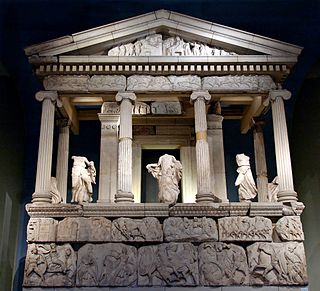 W
WThe Nereid Monument is a sculptured tomb from Xanthos in Lycia, close to present-day Fethiye in Mugla Province, Turkey. It took the form of a Greek temple on top of a base decorated with sculpted friezes, and is thought to have been built in the early fourth century BC as a tomb for Arbinas, the Xanthian dynast who ruled western Lycia under the Achaemenid Empire.
 W
WThe Kingdom of Pontus was a Hellenistic kingdom, centered in the historical region of Pontus and ruled by the Mithridatic dynasty of Persian origin, which may have been directly related to Darius the Great and the Achaemenid dynasty. The kingdom was proclaimed by Mithridates I in 281 BC and lasted until its conquest by the Roman Republic in 63 BC. The Kingdom of Pontus reached its largest extent under Mithridates VI the Great, who conquered Colchis, Cappadocia, Bithynia, the Greek colonies of the Tauric Chersonesos, and for a brief time the Roman province of Asia. After a long struggle with Rome in the Mithridatic Wars, Pontus was defeated. The western part of it was incorporated into the Roman Republic as the province Bithynia et Pontus; the eastern half survived as a client kingdom until 62 AD.
 W
WQadamgah or Chasht-Khor is an Achaemenid rock-cut monument at the southeastern part of the Kuh-e Rahmat mountain in Fars Province of Iran, about 40 km south of Persepolis. It consists of three platforms with rear walls and staircases, and features cavities on the back wall and a now-dry spring and pond at the bottom. Its function has been a matter of debate, with latest research pointing to a religious function related to the holy element Water.
 W
WReligious diversity has been a feature of Kurdistan for many centuries. Main religions that currently exist in Kurdistan are as follows: Sunni Islam, Shia Islam, Christianity, Zoroastrianism, Yarsanism, Yazidism, Alevism, and Judaism. Today, Sunni Islam is the most adhered religion in Kurdistan.
Homosexuality in Zoroastrianism is, as in many other religions, a controversial topic with differing consensus over time.
 W
WSharifabad, Ardakan is a township in the Central District of Ardakan County, Yazd Province, Iran. It is located near the county capital, Ardakan, and had a population of 4,000 as of the 2006 census. Sharifabad is one of the Zoroastrian centres of Iran, home to numerous Zoroastrian holy sites. Every summer, thousands of Zoroastrians from around the world gather here on pilgrimage. Sharifabad is also notable for the 1,000-year-old Qutbabad aqueduct that runs through the village. The village is home to both Muslims and Zoroastrians who worship separately and respect each other's beliefs.
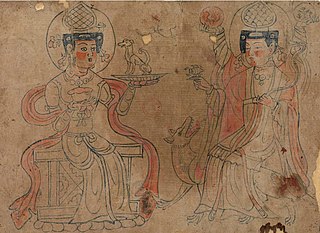 W
WSogdian Daēnās, also known as Sogdian Deities is a 10th-century line drawing discovered by the French Orientalist Paul Pelliot at the Mogao Caves. It was painted during the late Tang dynasty and the Five Dynasties and Ten Kingdoms period, and is probably associated with the Zoroastrian cult of the Sogdian people. The historian Zhang Guangda, who is a member of the Academia Sinica of Taiwan, recognised this "paper image" as one of the "pieces of paper depicting Mazdean deities for the saixian celebration". The drawing is preserved in the Bibliothèque nationale de France in Paris.
 W
WThe Kingdom of Sophene, was a Hellenistic-era political entity situated between ancient Armenia and Syria. Ruled by the Orontid dynasty, the kingdom was culturally mixed with Greek, Armenian, Iranian, Syrian, Anatolian and Roman influences. Founded around the 3rd century BCE, the kingdom maintained independence until c. 95 BCE when the Artaxiad king Tigranes the Great conquered the territories as part of his empire. Attempts to restore the kingdom were briefly made in 66 BCE and 54 CE. Sophene laid near medieval Kharput, which is present day Elazig.
 W
WThree Persian religions refers to the three religions that originated in Persia that were spread in China during the Tang period. They were recognized and protected by the Tang dynasty and prospered for a while.
 W
WThe Tomb of Payava is a Lycian tall rectangular free-standing barrel-vaulted stone sarcophagus, and one of the most famous tombs of Xanthos. It was built in the Achaemenid Persian Empire, for Payava, who was probably the ruler of Xanthos, Lycia at the time, in around 360 BC. The tomb was discovered in 1838 and brought to England in 1844 by the explorer Sir Charles Fellows. He described it as a 'Gothic-formed Horse Tomb'. According to Melanie Michailidis, though bearing a "Greek appearance", the Tomb of Payava, the Harpy Tomb and the Nereid Monument were built according to the main Zoroastrian criteria "by being composed of thick stone, raised on plinths off the ground, and having single windowless chambers".
A dakhma, also known as a Tower of Silence, is a circular, raised structure built by Zoroastrians for excarnation–that is, the exposure of human dead bodies to the elements for decay in order to avert contamination of the soil with the corpses. Carrion birds, usually vultures and other scavengers, would typically consume the flesh and the skeletal remains would have been left in the pit.
 W
WYenghe hatam is one of the four major prayer formulas of the Gathic canon, that is, part of the group of texts composed in the more archaic dialect of the Avestan language and believed to have been composed by Zoroaster.
Zoroaster, also known as Zarathustra, Zarathushtra Spitama or Ashu Zarathushtra, was an ancient Iranian prophet who founded what is now known as Zoroastrianism. His teachings challenged the existing traditions of the Indo-Iranian religion and inaugurated a movement that eventually became the dominant religion in Ancient Persia. He was a native speaker of Old Avestan and lived in the eastern part of the Iranian Plateau, but his exact birthplace is uncertain.
Zoroastrian prayer is performed for the worship of Ahura Mazda. The Zoroastrian place of worship is known as a fire temple.
 W
WThe Zoroastrian Trust Funds of Europe (ZTFE) is a religious, cultural and social organisation for Zoroastrians residing in Europe, mainly the United Kingdom. It was founded on 31 October 1861 by Muncherjee Hormusji Cama and Dadabhai Naoroji.
Zoroastrianism or Mazdayasna is one of the world's oldest continuously practiced religions, based on the teachings of the Iranian-speaking prophet Zoroaster. Zoroastrianism has a dualistic cosmology of good and evil and an eschatology which predicts the ultimate conquest of evil by good. Zoroastrianism exalts an uncreated and benevolent deity of wisdom, Ahura Mazda, as its supreme being. The unique historical features of Zoroastrianism, such as its monotheism, messianism, judgment after death, heaven and hell, and free will may have influenced other religious and philosophical systems, including Second Temple Judaism, Gnosticism, Greek philosophy, Christianity, Islam, and the Baháʼí Faith.
Zurvanism is a hypothetical religious movement of Zoroastrianism in which the divinity Zurvan is a First Principle who engendered equal-but-opposite twins, Ahura Mazda and Angra Mainyu. Zurvanism is also known as "Zurvanite Zoroastrianism", and may be contrasted with Mazdaism.